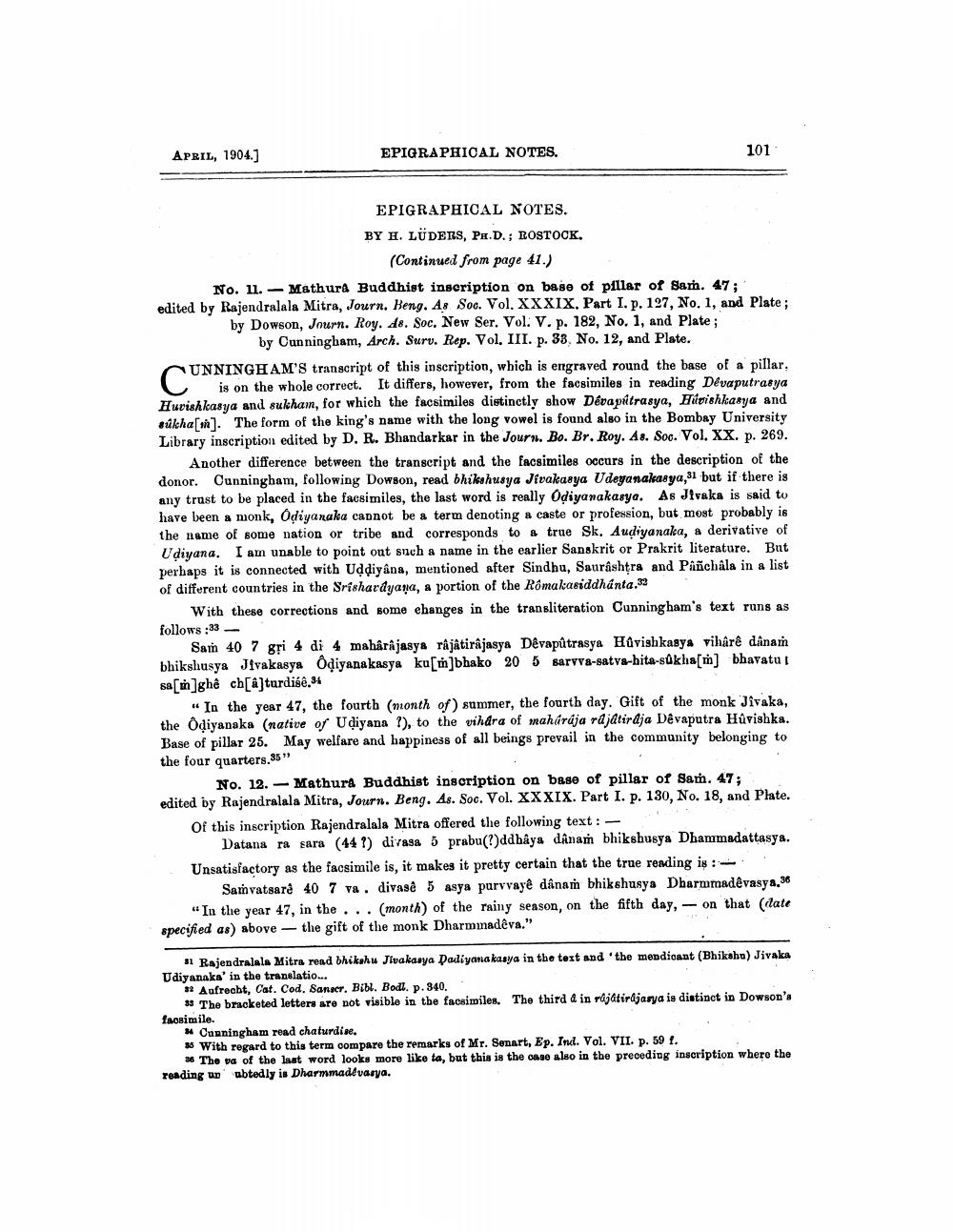________________
APRIL, 1904.]
EPIGRAPHICAL NOTES
101
EPIGRAPHICAL NOTES. BY H. LÜDERS, PH.D.; ROSTOCK,
(Continued from page 41.) No. 11. - Mathura Buddhist inscription on base of pillar of Sam. 47; edited by Rajendralala Mitra, Journ. Beng. As Soc. Vol. XXXIX. Part I. p. 127, No. 1, and Plate;
by Dowson, Journ. Roy. ds. Soc. New Ser. Vol. V. p. 182, No. 1, and Plate;
by Cunningham, Arch. Suru. Rep. Vol. III. p. 33. No. 12, and Plate. UNNINGHAM'S transcript of this inscription, which is engraved round the base of a pillar, U is on the whole correct. It differs, however, from the facsimiles in reading Dévaputrasya Huvishkasya and sukham, for which the facsimiles distinctly show Déva patrasya, Húvishkasya and súlcha ). The form of the king's name with the long vowel is found also in the Bombay University Library inscription edited by D. R. Bhandarkar in the Journ. Bo. Br. Roy. As. Soo. Vol. XX. p. 269.
Another difference between the transcript and the facsimiles occurs in the description of the donor. Cunningham, following Dowson, read bhikshusya Jivakasya Udeyanakasya, but if there is any trust to be placed in the facsimiles, the last word is really Odiyanakasya. As Jivaka is said to have been a monk, Odiyanaka cannot be a term denoting a caste or profession, but most probably is the name of some nation or tribe and corresponds to true Sk. Audiyanaka, a derivative of Udiyana. I am unable to point ont such a name in the earlier Sanskrit or Prakrit literature. But perhaps it is connected with Uddiyana, mentioned after Sindhu, Saurashtra and Pañchâla in a list of different countries in the Srishardyana, a portion of the Romakasiddhanta.32
With these corrections and some changes in the transliteration Cunningham's text runs as follows :33
Sam 40 7 gri 4 di 4 mahârâjasya râjâtirâjasya Devapútrasya Húvishkasya viharê dâna bhikshusya Jivakasya Odiyana kasya ka[mn]bhako 20 5 sarva-satya-hita-sûkha[m] bhavatu sa[n]ghê ch[@]turdisê. .
"In the year 47, the fourth month of summer, the fourth day. Gift of the monk Jivaka, the Odiyanaka (native of U diyana ?), to the vihdra of maharaja rajatiraja Dêvaputra Húvishka. Base of pillar 25. May welfare and happiness of all beings prevail in the community belonging to the four quarters.35"
No. 12. - Mathura Buddhist inscription on base of pillar of Sam. 47; edited by Rajendralala Mitra, Journ. Beng. As. Soc. Vol. XXXIX. Part I. p. 130, No. 18, and Plate. Of this inscription Rajendralala Mitra offered the following text:
Datana ra sara (441) divasa 5 prabu(?)ddhaya dânam bhikshusya Dhammadattasya. Unsatisfactory as the facsimile is, it makes it pretty certain that the true reading is :
Samvatsaré 40 7 va. divasé 5 asya purvvayê dânam bhikshusya Dharmmadêvasya.36 - In the year 47, in the ... (month) of the rainy season, on the fifth day, - on that date specified as) above the gift of the monk Dharmmadêva."
31 Rajendralala Mitra rend bhikshu Jivakasya Darliyana kasya in the text and 'the mendicant (Bhiksha) Jivaka Udiyanaka' in the translatio...
* Aufrecht, Cat. Cod. Sanger, Bibl. Bodl. p. 840.
» The bracketed letters are not visible in the facsimiles. The third Q in rajatirdjarya is distinct in Dowson's facsimile.
+ Cunningham read chaturdine. as With regard to this term compare the remarks of Mr. Sonart, Ep. Ind. Vol. VII. p. 59 1.
* The va of the laat word looks more like ta, but this is the case also in the preceding inscription where the reading up ubtedly is Dharmmade varya.




